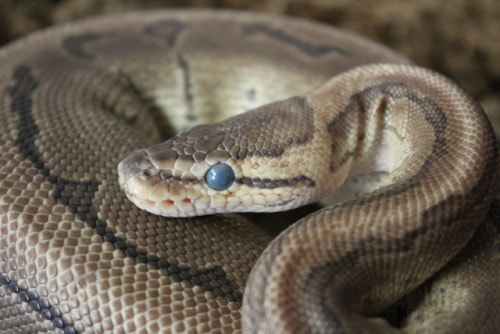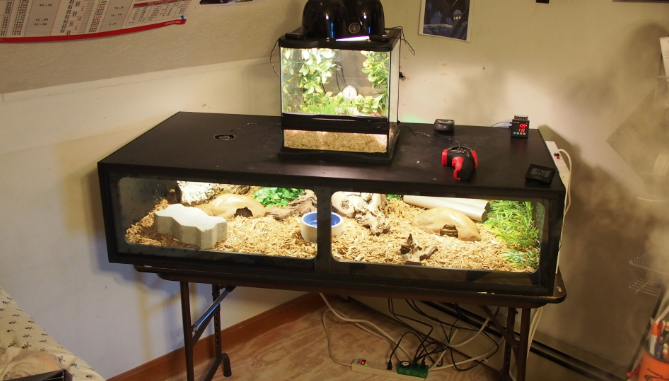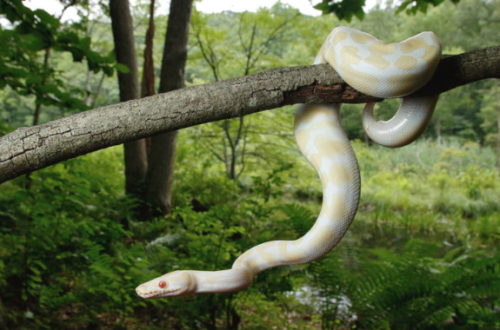Why Is My Snake Not Eating?
This time of year, and any time of year, you see posts all over social media asking about why their precious noodles are refusing to eat, especially ball pythons. There are a few reasons that can cause a snake to go off feed or refuse to eat from the start, most are easily addressed.
SHEDDING
 The most common reason a snake will refuse food is that it is in a shed cycle. If your snake’s eyes are cloudy, scales feel dry, or he has stuck shed still on him, he may refuse food. Simply wait until he has fully shed or remove any old shed, and try again.
The most common reason a snake will refuse food is that it is in a shed cycle. If your snake’s eyes are cloudy, scales feel dry, or he has stuck shed still on him, he may refuse food. Simply wait until he has fully shed or remove any old shed, and try again.
TEMPS
Temperatures are one of the biggest culprits of putting snakes off food. Even if you think your temps are good, still go through these suggestions and double and triple-check them.
First, put new batteries in your infrared temp gun and make sure you have a digital thermometer with fresh batteries as well. Make sure ground-level ambient and surface temps are appropriate for the species of snake you are keeping. For ball pythons, that would be 85-89 F ambient hot side with surface temps over a heat mat/pad or directly under your overhead heat no hotter than 95 F. Make sure the temps in your snake’s warm hide are at least 85 F. If they are in range, adjust them a couple of degrees anyway, up if they’re on the low end or down if they’re on the hot end of the range.
Your cool side should not dip too low, even at night. For Ball Pythons, your cool side should never dip below 75 degrees. 75 – 80 F ambient is the ideal range for the cool side. Make sure your surface temp is in this range as well. If you struggle with temps and use a glass tank, follow our guide for modifications.
Check for drafts! Make sure your enclosure is not near an outside door or window. It shouldn’t be on the floor either. Walk around the room and try to feel for any drafts. Check again on a particularly windy day. Visit your local home improvement or hardware store for weather-stripping and other remedies for drafty rooms or cold windows.
SECURITY
 Snakes need to feel safe and secure when eating. Eating makes them vulnerable. In the wild, they will regurgitate their last meal if pursued by a predator or otherwise accosted. Pet snakes are safe from predators, but they don’t know that. It’s up to their keeper to ensure they feel as stress-free and secure as possible.
Snakes need to feel safe and secure when eating. Eating makes them vulnerable. In the wild, they will regurgitate their last meal if pursued by a predator or otherwise accosted. Pet snakes are safe from predators, but they don’t know that. It’s up to their keeper to ensure they feel as stress-free and secure as possible.
MOVING TO FEED
It is, unfortunately, still recommended by some to move your snake to feed it to “avoid cage aggression.” Please don’t… This myth has been busted time and time again. It was a common practice in the 1980s, but we have learned a bit about reptile behavior and natural instincts since then. If you’re moving your snake to feed it, please stop. Feed them in the enclosure where they live and feel safe.
ENCLOSURE
One common stressor is a bare or clear-sided enclosure. If you use a glass tank, follow our guide for modifications to address feelings of vulnerability from exposure. Add another plastic hide or two that isn’t much larger than your snake coiled up. Go to a discount store and get some fake plants or vines, just be sure there are no sharp edges or loops they can get their nose in.
If you have a glass tank with a screen top, cover the lid as much as you can. Your snake can see up above it and it won’t recognize the screen as a protective barrier. Use all-weather duct tape or HVAC foil tape to cover 90% of the screen lid that is available to cover. This will make a “roof” for your snake to feel safe under and it will also help trap in heat and humidity.
How big is your enclosure? What size is your snake? Having a small snake in a large enclosure can be extremely stressful. If your snake is new, ask the previous owner or the breeder what the snake was living in. Consider putting your snake in the same size tub or enclosure, or downsizing at least one size smaller than what you are currently housing them in. If your snake is in a 40-gallon breeder, try a 20-gallon long. If they’re in a 4x2x2, go down to a 3x2x1 or similar size in a DIY bin/tub enclosure. Adding hides and clutter may not be enough to make your snake feel secure. You may need a smaller enclosure.
LIGHTING
If you’re using lights of any sort, even red or “night” light bulbs, turn them off. Snakes can see red or black/blue lighting, so using these at night upsets their day/night cycle. Bright basking lights, UVB lights, halogen bulbs, or LED lighting can stress some snakes out. Replace your heating lights with a non-light emitting heat source such as a ceramic heat emitter or deep heat projector if you have a screen-top enclosure, or a radiant heat panel if you have an enclosure with a solid top (PVC or wood). A window that lets in light is usually enough to create a day/night cycle for your snake.
If you prefer to provide beneficial lighting for your snake, leave the UVB light off until your snake starts eating regularly. Once he is back on food, try turning them back on. If your snake goes back off food when you do, add more fake plants and hide and try again. If that still doesn’t help, your snake is just not going to do well with lighting of any kind. It’s better to have a snake that eats regularly than one that gets a little UVB but refuses meals.
OUTSIDE ENVIRONMENT
The room your snake’s enclosure is in can affect their sense of security as well. Take a look around critically and think about each of these questions:
- Is there a TV, stereo, or other sound-emitting electronics near my snake’s enclosure or on the same wall?
- Does the room recieve a lot of foot traffic?
- Do other pets have access to my snake’s enclosure? (ie. can cats sit on it or dogs look in)
- Are there children in the home that may be banging on the glass or simply running around the room?
- Does this room have bright lights that are on and off during different times of the day or night?
If you answered yes to any of the above questions, consider moving your snake into another room that is quiet and free from these stressors.
FEEDER SIZE/TYPE
First and foremost, do not attempt to feed your snake too often. This can stress them out. Only offer food once every 5-7 days. Here are a few feeder-related tips to try, especially if this snake is new to your home or it’s looking a little thick.
- Try going down a size in feeder. If you normally feed a small rat, go down to a weaned size or a pup.
- If you feed frozen normally, try a live feeder of the same size/type the snake normally eats. After a few live meals, try switching back to frozen. Check this blog entry for tips on getting your snake back on frozen food.
- If those two fail, try a different prey-type in the smaller size. If you feed a small rat, try a large or XL mouse or a quail chick. Feeders that you can often find at stores or online: African Soft Fur rats, gerbils, hamsters, rabbits, guinea pigs, chicks/chicken, quail, and pigs. These come in many sizes. Check the weights to compare to what you have been feeding regularly.
OTHER POSSIBLITIES
Less common than above, there are a few other reasons your snake could be going off food.
- POOP! Some snakes don’t like to eat where they have recently pooped. Give the enclosure a full cleanout, put in all new substrate, sanitize the enclosure and everything in it, really scrub hides and your water bowl. Let your snake settle in to his fresh digs for a few days, then try a smaller meal in the evening (around dusk or just after). Check out Kinova’s YouTube video about this issue: https://www.youtube.com/watch?v=a-aU7VJLvaY
- Illness/Injury: Listen closely to your snake’s breathing. Does it sit with the head pointing straught up for long periods of time or with the mouth wide open? Has it had a bowel movement recently? Do you see any swelling around the mouth or neck area? Do you see anything else wrong with the scales or body mass? A trip to the vet is in order if you notice anything off about the physical health of your snake.
- Mites: Check your snake over thoroughly for mites. Look under their jaw, around the cloaca, and around the eyes. They will be little black specks wedged under the scales. Your snake may be soaking more often if he has mites.
- Breeding Season Hormones: If you keep both male and female snakes of the same species that are coming up to or at sexual maturity, they may be thinking more about meeting their friends than eating. However, if you’re not actively breeding, this is not a very likely scenario. Separate male and female snakes into separate rooms. Handle males first before handling females.
- Breeding: If you are breeding your snakes, males may go off food. If he is losing weight, separate him from the girls and do not pair again until he has eaten a couple of meals. Overworking your boys will put them off food. Females will often go off food when they ovulate and/or just before laying eggs. After she lays and you pull the eggs for incubation, wipe her down with a damp cloth and thoroughly clean and disinfect her tub/enclosure to get the smell of her eggs out. Try feeding her a smaller meal about a week later, like a weaned size rat or XL mouse.
Here is a great YouTube video addressing four major reasons that they go off food. It was put out by Kinova, an industry leader in Ball Python breeding.
https://www.youtube.com/watch?v=qBSekNhKOGk



